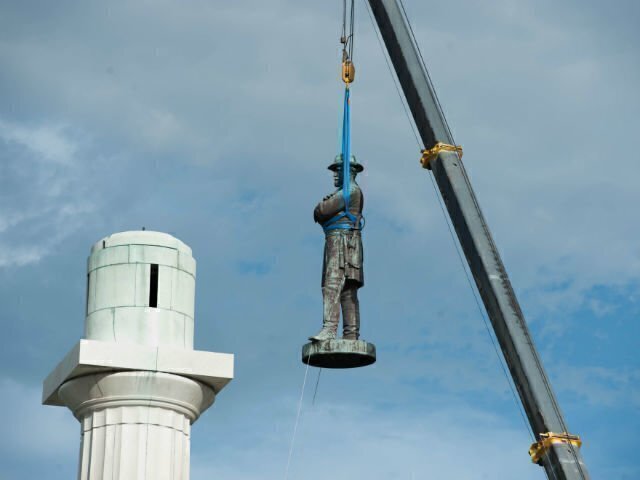 On May 19, a statue of Confederate General Robert E. Lee was removed from a major traffic circle in New Orleans. It was the last of four public displays designated for removal by the city council in December 2015. The monuments included tributes to Confederate President Jefferson Davis and General P.G.T. Beauregard, as well as a commemoration of the Battle of Liberty Place, a Reconstruction-era uprising of a white militia to overthrow the city government.
On May 19, a statue of Confederate General Robert E. Lee was removed from a major traffic circle in New Orleans. It was the last of four public displays designated for removal by the city council in December 2015. The monuments included tributes to Confederate President Jefferson Davis and General P.G.T. Beauregard, as well as a commemoration of the Battle of Liberty Place, a Reconstruction-era uprising of a white militia to overthrow the city government.
Police were on hand for each removal, often in the dead of the night, and residents on both sides of the debate frequently clashed. But despite the controversy, and despite a flurry of legal maneuvers to stop removal, the monuments are now gone, stored in secret until the city council agrees on their future use.
“The Confederacy was on the wrong side of history and humanity,” declared Mayor Mitch Landrieu in a speech the same day. “It sought to tear apart our nation and subjugate our fellow Americans to slavery. This is the history we should never forget and one that we should never again put on a pedestal to be revered.”
Supporters, led by Take ‘Em Down NOLA, contend that the monuments are symbols of white supremacy that communicate messages of inferiority and exclusion to large segments of the population. They say the monuments offer a rosy and incomplete understanding of history by ignoring the real horrors of slavery and obscuring the causes and consequences of the Civil War.
Opponents, bolstered by the Monumental Task Committee, argue that removing the monuments is tantamount to suppressing history and erasing the region’s cultural heritage. They also see the monuments as tributes to military veterans who defended their homes and liberties; taking them down is disrespectful and nothing more than political correctness run amok.
This is not a new debate. As the Southern Poverty Law Center recounted last year in Whose Heritage?, public displays honoring the Confederacy have drawn opponents for decades, yet have remained largely untouched. But after Dylan Roof murdered nine African Americans at the “Mother Emanuel” church in Charleston, South Carolina, in June 2015, opponents reemerged with urgency. Since Charleston, there have been at least 100 attempts at the state and local levels to remove or alter Confederate displays. Perhaps most memorably, the Confederate flag was removed from the South Carolina statehouse grounds.
According to the SPLC, over 1,500 symbols of the Confederacy remain in public spaces across the country. These include monuments and statues, like those at issue in New Orleans, as well as flags, holidays, schools, roads, cities and much more. Since the Civil War, there has been a steady stream of new monuments, but there were two major periods in which dedications spiked: the turn of the century, at the height of Jim Crow; and the civil rights movement of the 1950s and 1960s.
What are citizens to make of all this? Americans might start by noting the differences between “history” and “memory." The historian David Blight offers this useful elucidation in Beyond the Battlefield:
History—what trained historians do—is a reasoned reconstruction of the past rooted in research; it tends to be critical and skeptical of human motive and action… History can be read by or belong to everyone; it assesses change and progress over time, and is therefore more relative, more contingent upon place, chronology, and scale. Memory, however, is often treated as a sacred set of potentially absolute meanings and stories, possessed as the heritage of identity of a community.
Memory is often owned; history, interpreted. Memory is passed down through generations; history is revised. Memory often coalesces in objects, sacred sites, and monuments; history seeks to understand contexts and the complexity of cause and effect. History asserts the authority of academic training and recognized canons of evidence; memory carries the often more powerful authority of community membership and experience. Or as the French historian Pierre Nova put it, ‘memory dictates, while history writes.’
After the Civil War, two approaches to memory emerged, each with its own relationship to history, as the historian Eric Foner explains in a review of Blight’s seminal work, Race and Reunion. The “emancipationist” approach saw the war as a “rebirth of the republic”—indeed, a Second Founding—in the name of freedom and equality.” The “reconciliationist” approach, on the other hand, “emphasized what the two sides shared in common, particularly the valor of individual soldiers, and suppressed thoughts of the war’s causes and the unfinished legacy of Emancipation.”
The recent debate over Confederate monuments in New Orleans may thus be understood as the latest skirmish in the ongoing struggle between these two approaches. After all, decisions about who or what to include in public displays about the Civil War do not occur in a vacuum. They are laden with values; they are tools of power; and they continue to shape our collective memory of a war that infused the fundamental constitutional principles of liberty and equality with new meaning.
Nicandro Iannacci is a web content strategist at the National Constitution Center.
Recent Stories on Constitution Daily
‘Ask Jeff’ about the Constitution







